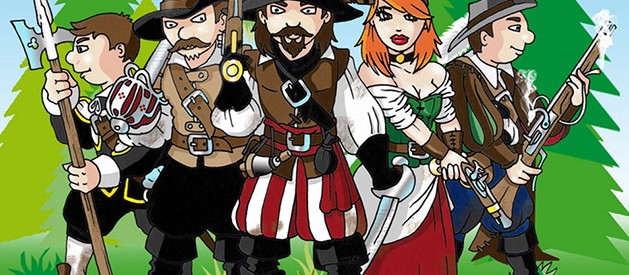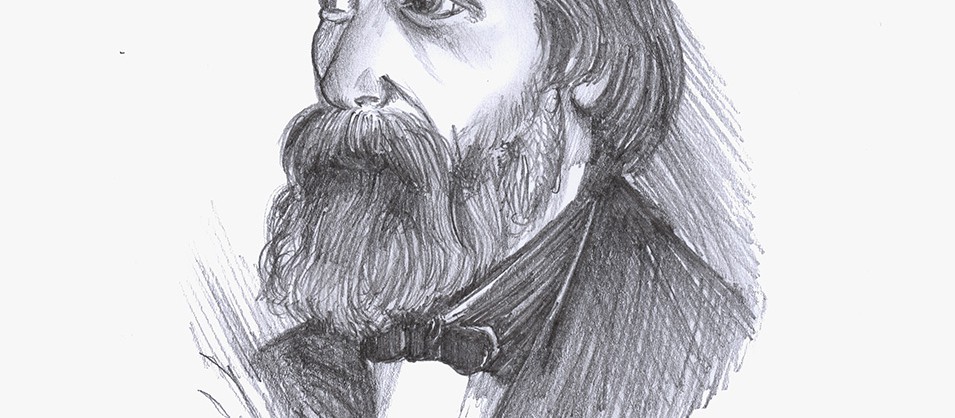
The educational journey of the robber Stetka
A nature trail around the surroundings of Štětí for the whole family, introducing the history and picturesque nature, industry and agriculture of Štetsko. The legendary robber Štětka and his four-member team are guiding the tour, giving information on a marked circuit starting from
In the old days of the Thirty Years' War, the robber Štětka was the master of the deep forests, fields and hillsides around the town of Štětí. Today, his home is the former Mordloch Cave, hidden away from people in the middle of the Stračen forests. Who knows him in the region. He protects the poor and honest, and justly punishes dishonesty and avarice. He has walked this land many times. He knows every road and footpath here.
During your adventurous journey with the robber Stetka you will come across educational boards that will tell you all about the history, nature, fauna and flora, industry and agriculture of the local region or visit the mythical cave Mordloch of the robber Stetka. You can also try out a discovery competition Following the footsteps of the robbers or robber geocaching.
Stops

Stracci parking lot
ROCK FORMATIONS OF THE STETTIN REGION
Rocks of the Kokořín Protected Landscape Area - Macha Region
Kokořínsko is known mainly as a picturesque landscape of sandstone rocks. Natural rock formations often create bizarre shapes, so in the protected landscape area we can find for example the Giant's Head, Frog, Boar, Elephant, Bear, Snow White and the Seven Dwarfs, Baron and Countess, Cardinal and Marquise or the most famous Pokličky. Rock formations have often been modified by man, whether for purely practical reasons - the creation of rock dwellings (Staráky, Nedamy, the rock mill of Hlučíc, the Stone Hive, the Petrified Castle) or artistic reasons (sculptural works by Václav Levy).
Mordloch and the Seven Loaves
One of the most interesting tourist localities in the region is undoubtedly the part of the Kokořín - Macha Region, which also extends into the Štětsek cadastre. The picturesque landscape is dotted with many sandstone formations, rock massifs and caves. Among those with the most interesting reputation is certainly the Mordloch Cave - it is an artificially created cave with a legend of robbers from the Thirty Years' War. Practically in front of it you can see a rock sculpture called the Seven Loaves. That is, a rock resembling seven stacked loaves of bread. Other interesting rock formations include Ontario, also known as Frog Cave.
Statues of Václav Levy
Many of the local rock formations served as material for monumental works by the sculptor Václav Levy, who created many interesting rock sculptures here in the 1850s. His most famous works in the Štětska region are the sculptures Serpent - a roughly five-metre-long image of a snake carved into the rock, and Harpers - a relief representing four human heads, next to which is an ornate cave and a relief of a woman with a harp. Another work is the rock chapel of Mary Magdalene.
Nearby are the Devil's Head and Klácelka. The Devil's Heads are located on a sandstone block above the village of Želízy. They are reliefs of the heads of fairy-tale creatures, perhaps resembling devils, carved into two rock blocks. and are some of the largest forest sculptures by the sculptor Vaclav Levy. Klácelka is an artificial cave with reliefs also by Levy. It consists of two parts. The first part, the area in front of the cave, is called Blaník with heroic figures of our national history. The second is the actual artificial cave Klácelka, accessible through a richly decorated portal. There are stone benches along the walls, and it is said that there was also a stone table. The walls are decorated with reliefs from the fable Ferin the Fox by F. M. Klácel and from the designs of the French cartoonist Grandville.
Sculptor Václav Levý
Václav Levý was an important Czech sculptor, the founder of "modern" Czech sculpture and the teacher of sculptor Josef Myslbek. His work combines early romantic and patriotic rock sculptures with monumental and poetic sculptures that transcend the academicism of the time and lay the foundations of Czech national sculpture that were later developed.
Václav Levý was born on 14 September 1820 in Nebřeziny near Plas. At the age of two, the family moved to Kožlany, where they settled permanently. Here the young boy's talent was formed, especially in carving inspired by. However, his artistic interests were not shared by his parents, who had him apprenticed as a carpenter. After leaving his studies, he met by chance a patron of the arts, the landowner Antonín Veith, into whose service Levý entered in 1844 at the age of twenty-two as a cook at the chateau in Liběchov near Mělník. Levy's talent as a sculptor was not hidden from the many guests from artistic circles who visited the landowner. In early 1845, at the suggestion of Veith's librarian, the Brno Augustinian Professor Matúš Klácel, he created a relief decoration of Klácelka in the woods on the hillside above Liběchov. The works Snake and Harfenice near Stračí near Štětí were probably created at the same time. The successful execution of Klácelka prompted Veith to send Levy to Munich at the end of 1845 to study with one of the most renowned sculptors, his friend Ludwig Schwanthaler.
At the end of 1849, Levý returned to Liběchov and in 1850 he continued to decorate Klácelka - this time carving national motifs from Czech history - Blaník - Jan Žižka, Prokop Holý, etc. After the death of his patron Veith, Levý left for Prague and later went to Rome to study. However, the liver disease acquired in Rome takes its toll and Levý is able to personally portray only a small part of the commissions and most of them he creates in collaboration with his best pupil Josef Myslbek. However, his illness progressed and Levý died prematurely on 29 April 1870.
